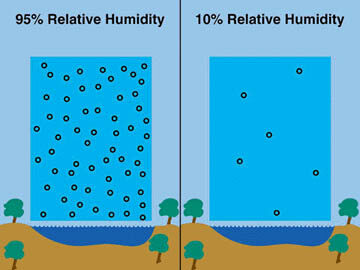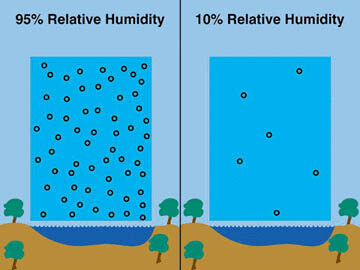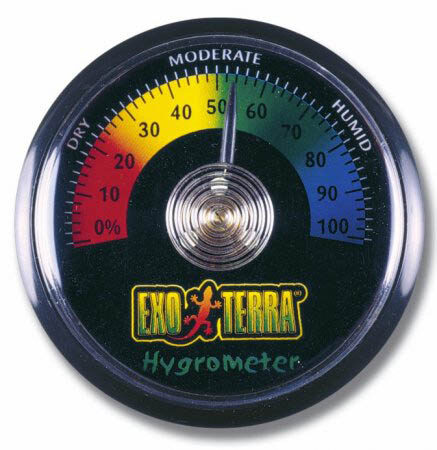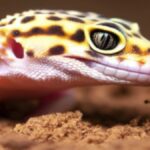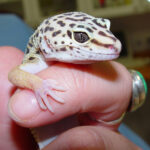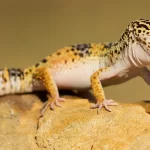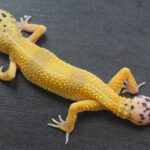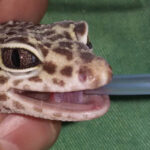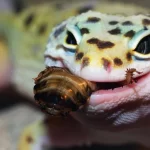There are two main environmental variables Leopard gecko keepers need to ensure (e.g. temperature and light), but what about humidity?
The humidity is basically the amount of water, in the form of vapour, in the air. In more technical terms it can be expressed as the relative humidity which is the amount of vapour in the air as a percentage of the space of air that can hold vapour. Higher percentages mean higher humidity and vice versa.
A visual example of relative humidity (RH). The area above the water source represents the air in which water can evaporate and the particles represent the water particles. Image from blog.cashins.com
Just think of your Leopard gecko’s enclosure as a closed space of air, and the humidity as the amount of water in that space. Being enclosed, that area’s humidity will be different from the room the enclosure is situated at.
Factors affecting humidity
Apart from the size, or the area for water to evaporate in (which is usually relatively small in the case of Leopard gecko enclosures), factors such as the ventilation, temperature, substrate and the amount of water available also greatly affect the humidity.
Comparatively more ventilation, larges spaces, less water and lower temperatures lead to lower relative humidities. The opposite is true for less ventilation, smaller spaces, more water and higher temperatures.
In the case of pet Leopard geckos, we have the most control over the temperature (e.g. heat pads) and the amount of water (e.g. size of the water dish and hiding boxes).
What humidity are we talking about for keeping Leopard geckos?
Remember that Leopard geckos originate from the drier and desert areas of Afghanistan, Pakistan, India and Iran. The outside humidity in these areas is on average about 40 – 50% – which is quite low compared to non-desert areas.
Saying this, Leopard geckos are also considered ground-dwelling, and during the day, hideaway in small areas where the humidity is a little higher.
In other words, pet Leopard geckos need relative low humidities with hiding areas of higher humidities.
Why humidity is important for keeping Leopard geckos
Generally, too high humidities will lead to an increase in diseases. In this case, diseases such as intestinal parasites, skin and mouth infections, and pneumonia are more common.
When the humidity is too low, the risk for dehydration, overheating and skin shedding problems increase.
How will I know what the humidity is like?
The humidity can be measured with a hygrometer. By looking around, small commercial hygrometers might be available from some pet shops and on the internet. Some Leopard gecko keepers are also handy enough to make their own hygrometer.
Exo-Terra produces a very popular, small and cost-effective reptile hygrometer. Available from Amazon.com
A terrarium hygrometer can be placed directly in the space where you want to measure the humidity. It is always a good idea to take multiple readings, for example during the day and during the evening.
Approaching humidity in Leopard geckos
First of all, it is important to note that the humidity will vary from setup to setup, i.e. no two Leopard gecko enclosures will have exactly the same humidity.
Before changing anything, or before finalising the setup, test the humidity first.
The general idea is to have an enclosure with fairly low humidity and hiding areas with higher humidities. My first guideline is to have a small water dish with a hide box filled with moist (not wet), clean peat/sphagnum moss or vermiculite. This will work for the majority of setups. Both the hide box and the water dish should be placed in the cooler side of the enclosure.
When, after testing, the enclosure humidity is still grossly incorrect, a smaller water dish, lower temperature and more ventilation will decrease the humidity. When it is really on the low side (e.g. < 40%), it can be increased by doing the opposite.
How will I know the humidity is incorrect?
The problem is that you might not know until it is too late. It must also be noted that even incorrect humidities might not necessarily lead to problems, ever, but for those that might show problems, the problems can be severe and even lead to death.
Apart from unrecommended humidity measurements, keepers might also pick up something is wrong when a Leopard gecko spends too much time in the water dish or in hiding. Other geckos might try to escape by climbing the wall of the container while others might show open-mouth breathing or poor appetites.

